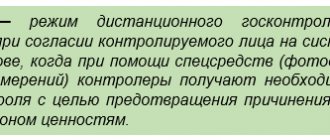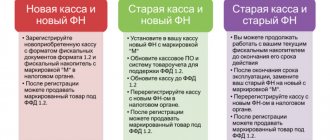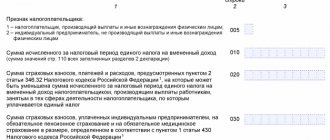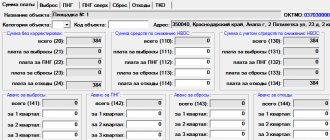Introductory information
Starting from July 2022, the Tax Code will contain a list of grounds on which inspectors can declare that reports have not been submitted (new clause 4.1 of Article 4.1 of the Tax Code of the Russian Federation).
The list is closed, and one item is dedicated to the VAT return. If the control ratios are not met in the declaration submitted after July 1, 2021, then the tax authorities will recognize such a report as not submitted (for more information about the consequences, see “On what grounds will the tax authorities not accept reports submitted after July 1”). Determine the likelihood of an on-site tax audit and receive recommendations on the tax burden
The specified control ratios are listed in the Federal Tax Service order dated 05.25.21 No. ED-7-15-/ [email protected] (see “Control ratios have appeared for checking VAT returns submitted after July 1”). Let's figure out what the essence of each of them is.
The amount “payable” must be equal to the difference between the accrued VAT and the deduction
This condition is mandatory only for those whose accrued tax at the end of the quarter is greater than or equal to the deduction. How can I check this? Compare two figures from section 3 of the VAT return:
- on line 118;
- on line 190.
If the first digit is greater than or equal to the second, then the equality must be fulfilled:
| indicator from line 200 of section 3 | = | indicator from line 118 of section 3 | – | indicator from line 190 of section 3 |
Exchange a legally significant “primary” without leaving 1C
The amount “to be paid” must be equal to the difference between the accrued VAT and the tax “to be reimbursed”
This control ratio will be observed only if in the declaration the total amount “to be paid” is greater than or equal to the total amount “to be reimbursed”. To check this, you need to compare two numbers:
— sum of indicators: from line 200 of section 3; from line 130 of section 4; from line 160 of section 6;
- sum of indicators: from line 210 of section 3; from line 120 of section 4; from line 080 of section 5; from line 090 of section 5; from line 170 of section 6.
If the difference between the first and second digits is not less than zero, the equality must be satisfied:
| indicator from line 040 of section 1 | = | sum of indicators: from line 200 of section 3; from line 130 of section 4; from line 160 of section 6 | – | sum of indicators: from line 210 of section 3; from line 120 of section 4; from line 080 of section 5; from line 090 of section 5; from line 170 of section 6 |
Checking the VAT return on accounting accounts
First of all, the declaration is checked against the accounting accounts. To do this, balance sheets are formed and analysis is carried out on the following accounts:
- 90 and 91 - to check sales in terms of VAT rates;
- 60, 62 and 76 - to check the amounts of advances and VAT;
- 19 - to check the amounts of VAT declared for deduction;
- 68 - to check the total amount of tax payable.
Checking the score 19
We start with an analysis of the postings Dt 68.02 Kt 19. The amount for these postings is the amount of VAT claimed for deduction. In the declaration, this number must be reflected in line 120 of Section 3.
Checking the score 76
We analyze the wiring Dt 76.AV Kt 68.02. Here we see VAT calculated on advances received from buyers. The amount for debit 76.AB falls into line 070 of Section 3 of the declaration. In addition, there are also postings Dt 68.02 Kt 76.AB. This is the amount of VAT on credited advances from buyers. Credit turnover 76.AB should fall into line 170 of Section 3.
Checking the account 90.03
Let's look at the postings Dt 90.03 Kt 68.02. This is the amount of VAT charged on sales. See these postings in the context of applicable VAT rates. If you only use the 20% rate, you will see this amount on line 010 of Section 3 of the VAT return.
Checking the score 62
Information on account 62 must be correlated with turnover on other accounts and the corresponding lines in the declaration. To check the ratio, use the formulas:
- Dt 62.1 * 20/120 = Dt 90.03 = line 010 of Section 3;
- Kt 62.2 * 20/120 = Dt 76.AB = line 070 of Section 3;
- Dt 62.2 * 20/120 = Kt 76.AB = line 170 of Section 3.
Keep records of exports and imports in the Kontur.Accounting web service. Simple accounting, payroll and reporting in one service
Checking the score 60
For this account, check only one ratio:
Kt 60 * 20/120 = Dt 19.03, which in turn should be equal to line 120 of Section 3.
Checking the account 68.02
We compare the debit and credit turnover of account 68.02. The loan balance is the amount of tax due. It appears in line 200 of Section 3. The debit balance is VAT refundable. It is reflected in line 210 of Section 3.
We check the execution of all purchase and sales documents
Check that all sales and purchase documents have been completed. If you do not have enough sales documents, you will underestimate the amount of tax payable in your return. If purchase documents are not posted, you will not claim part of the VAT for deduction.
The amount of VAT on incoming invoices must be equal to the total deduction from the purchase ledger
Let us remind you: the data from each incoming invoice is reflected in the corresponding lines of section 8 of the VAT return.
In particular, line 180 of this section indicates VAT on the invoice, or the difference in the amount of VAT on the adjustment invoice. The number of lines 180 corresponds to the number of invoices received from suppliers in the tax period (quarter).
The total amount of the deduction is reflected once - in line 190 of section 8 of the declaration.
Inspectors are required to ensure that the sum of the figures from all lines 180 equals the figure from line 190 of section 8.
Automatic reconciliation of invoices with counterparties will reduce the risk of additional VAT charges Check for free
Source documents
Receipt of goods
To begin with, we will reflect the supply of one hundred boards at a price of 75 rubles with the document “Receipt (acts, invoices).” The total cost will be 7,500 rubles. VAT in our situation will be 18%.
According to the BU and NU register, the document created two movements: 7500 and 1350 rubles (according to VAT).
Our team provides consulting, configuration and implementation services for 1C. You can contact us by phone +7 499 350 29 00 . Services and prices can be seen at the link. We will be happy to help you!
Invoice received
Now we must register the invoice received from the supplier. This can be done directly from the document card by entering the invoice number and date.
The invoice was created and filled out completely automatically.
Please note that we have automatically set the flag in the item “Reflect VAT deduction in the purchase book by the date of receipt.” If it is not set, then the reflection in the purchase book will not be the date of the invoice, but the date of the receipt document.
The document created one movement in four registers at once. The amounts from the accumulation register “VAT purchases” are entered into the purchase book. This invoice was also reflected in the accounting journal. The “VAT presented” register takes into account the expense portion of the completed purchase.
Adjustment of receipts
Suppose that initially we wanted to buy 100 boards at a price of 75 rubles, but later it turned out that the price per unit of goods increased by 50 kopecks. In this regard, Roga LLC provided us with an adjustment invoice.
These changes can be reflected in 1C 8.3 directly from the receipt document. Select "Adjustment Invoice" from the "Create Based on" menu.
In the automatically created document, go to the “Products” tab and change in the “after change” line the price for one board from 75 rubles to 75.5 rubles.
This document calculated the difference in the amount of 50 rubles, as well as VAT on this amount and reflected it in the “VAT presented” register.
Corrective invoice received
Just as with a regular receipt for an adjustment, you also need to indicate an invoice. This can be done in a similar way to the previously described method by entering its date and number into the adjustment document. After that, click on the “Register” button.
Receipt of fixed assets
Let us reflect in the 1C:Accounting 3.0 program the purchase of a lathe worth 350,000 rubles as a fixed asset.
Please note that you cannot receive a VAT deduction for a fixed asset until you accept it for accounting. Let's do it simpler and create not an influx of fixed assets, but an influx of equipment. A document with this type of operation allows us to immediately register our machine.
This document immediately indicates the data to be accepted for accounting, including depreciation.
If you go to 1C to the transactions of receipt of fixed assets, you will see movements on receipt and on acceptance for accounting in the accounting register, as well as “VAT presented”.
Invoice received
The invoice is registered in exactly the same way as when goods and services are received. It reflected a total amount of 413,000 rubles, including VAT of 63,000 rubles.
When posted, this invoice was reflected in the corresponding accounting journal.
In the “clarification”, the corrected deduction must be equal to the sum of the original value and all adjustments
When checking the updated VAT return, tax authorities will look to see whether Appendix No. 1 to Section 8 is filled out correctly. It is necessary that the adjusted deduction amount be made up of two components. The first is the original deduction value for the period being corrected. The second is the sum of all corrections made.
The reference ratio is as follows:
| indicator from line 005 of Appendix No. 1 to Section 8 | + | the sum of indicators for all lines 180 of Appendix No. 1 to Section 8 | = | indicator from line 190 of Appendix No. 1 to Section 8 |
The VAT amount on outgoing invoices must be equal to the total tax amount from the sales ledger
Information from each issued invoice is reflected in the corresponding lines of section 9 of the VAT return.
In particular, line 200 of this section indicates VAT on the invoice (the difference in the amount of VAT on the adjustment invoice) at a rate of 20%. The number of lines 200 corresponds to the number of invoices issued to customers, in which tax is allocated at a rate of 20%.
The final amount of VAT, accrued at a rate of 20%, is reflected once - in line 260 of section 9 of the declaration.
Inspectors are required to ensure that the sum of the figures from all lines 200 equals the figure from line 260 of section 9.
Similar control ratios are provided for other rates:
| For VAT rate 20% | ||
| the sum of indicators for all lines 200 of section 9 | = | indicator from line 260 of section 9 |
| For VAT rate 10% | ||
| the sum of indicators for all lines 210 of section 9 | = | indicator from line 270 of section 9 |
| For VAT rate 18% | ||
| the sum of indicators for all lines 205 of section 9 | = | indicator from line 265 of section 9 |
Connect to the system for exchanging electronic invoices
Purchase book according to resolution 1137
According to Resolution 1137, the purchase book is filled out in the following order (clause 6 of the Rules for maintaining the purchase book):
- Column 1 indicates the serial number of the record of information about the invoice (including adjustment);
- in column 2 the code of the type of operation is entered (see order of the Federal Tax Service of Russia dated March 14, 2016 No. ММВ-7-3/ [email protected] );
- Column 3 generally reflects the serial number and date of the seller’s invoice; if the deduction is confirmed by other documents, then their details are provided (for example, a customs declaration, an application for import, etc.);
| Data to fill out column 3 | Under what conditions |
| No. and date of the application for the import of goods and payment of indirect taxes with marks from the tax authorities regarding the payment of VAT | When importing goods into the Russian Federation from EAEU countries |
| Registration number of the customs declaration issued upon release of goods in accordance with the customs procedure for release for domestic consumption upon completion of the customs procedure of the free customs zone on the territory of the SEZ in the Kaliningrad region | When reflecting VAT in the purchase book, which is accepted for deduction on the basis of clause 14 of Art. 171 Tax Code of the Russian Federation |
| No. and date of the payment and settlement document or other document containing summary (summary) data registered by the seller in the sales book | When reflecting VAT on an advance (prepayment) received on account of upcoming supplies of goods and materials and subject to deduction from the date of shipment of goods and materials |
- in columns 4–6 - serial numbers and dates of corrected, corrective or amended adjustment invoices;
- in column 7 - the number and date of the document confirming payment of the tax (you must reflect the details of the payment document in column 7 of the purchase book if VAT is deducted only after it is paid: for example, when importing goods into the Russian Federation (see letter from the Ministry of Finance Russia dated November 26, 2014 No. 03-07-11/60221) or return of the advance payment to the buyer in case of termination/change of the contract, letters of the Ministry of Finance of Russia dated March 24, 2015 No. 03-07-11/16044 and March 23, 2015 No. 03-07-11 /15889);
- in column 8 - the date of registration of goods (performance of work, provision of services), property rights;
- in columns 9 and 10 - the name and INN/KPP of the seller, respectively;
- columns 11 and 12 are filled in by the buyer-committee (principal) - they indicate the name, tax identification number and checkpoint of the intermediary commission agent (agent) purchasing the goods and services on his own behalf;
- in column 13 - the name and code of the currency (only in the case of purchasing goods and services, property rights for foreign currency);
- in column 14 - the cost of goods and services, property rights or the amount of the advance payment including VAT;
- in column 15 - the amount of VAT accepted for deduction;
- in column 16 - the registration number of the goods declaration or the registration number of the batch of goods subject to traceability;
- in column 17 - code of the quantitative unit of measurement of the product used for traceability purposes;
- in column 18 - the quantity of goods subject to traceability, in the quantitative unit of measurement of the goods used for traceability purposes;
- in column 19 - the cost of the goods subject to traceability, excluding VAT, in rubles.
A sample of filling out the purchase book using the new form from 07/01/2021 can be downloaded from ConsultantPlus by receiving a free trial access:
In the “clarification”, the corrected VAT must be equal to the sum of the original value and all adjustments
When checking the updated VAT return, inspectors will find out whether Appendix No. 1 to Section 9 is filled out correctly. The goal is to make sure that the adjusted amount of the accrued tax consists of two components. The first is the initial value of VAT presented to buyers for the period being corrected. The second is the sum of all corrections made.
The control ratios for various rates are as follows:
| For VAT rate 20% | ||||
| indicator from line 050 of Appendix No. 1 to Section 9 | + | the sum of indicators for all lines 280 of Appendix No. 1 to Section 9 | = | indicator from line 340 of Appendix No. 1 to Section 9 |
| For VAT rate 10% | ||||
| indicator from line 060 of Appendix No. 1 to Section 9 | + | the sum of indicators for all lines 290 of Appendix No. 1 to Section 9 | = | indicator from line 350 of Appendix No. 1 to Section 9 |
| For VAT rate 18% | ||||
| indicator from line 055 of Appendix No. 1 to Section 9 | + | the sum of indicators for all lines 285 of Appendix No. 1 to Section 9 | = | indicator from line 345 of Appendix No. 1 to Section 9 |
Request a tax reconciliation report from the Federal Tax Service via the Internet Request for free
For tax agents using the simplified tax system: there should be no deductions in the declaration (applicable from January 2022)
In some cases, organizations and individual entrepreneurs are recognized as tax agents for VAT. This happens, in particular, if they rent federal or municipal property. Or they pay for goods (work, services) to foreign persons who are not registered for tax purposes in the Russian Federation (Article 161 of the Tax Code of the Russian Federation).
When transferring money, the tax agent is obliged to withhold VAT and transfer it to the budget. Further, as a general rule, he has the right to deduct input tax. But the deduction is not possible for everyone, but only for VAT payers. As for the “simplified” people, they cannot present it.
Find out OKVED, taxation system and income of your counterparty
VAT returns are submitted by all tax agents, including those using the simplified tax system. But the amount of the deduction presented should be zero. It is necessary to fulfill the equality:
| indicator from line 180 of section 8 | = | indicator from line 190 of section 8 | = | 0 |
There is one exception. It is designed for operations for the purchase of raw animal skins, scrap and waste of ferrous and non-ferrous metals, as well as waste paper. Such companies and individual entrepreneurs put code 1011715 in line 070 of section 2 of the declaration. Having seen this value, inspectors will not apply the above control ratio.
What does not need to be recorded in the purchase book
Invoices compiled by:
- when transferring goods (work, services) free of charge;
- for the amount of prepayment for goods purchased for VAT-free transactions;
- Advance invoices generated or received after the seller has received shipping invoices.
Invoices are not recorded in the purchase book by commission agents:
- for goods received from the principal (work, services, property rights) that are transferred for sale;
- when receiving advances from buyers for upcoming deliveries;
- for goods received from sellers (works, services, property rights) purchased for the principal;
- on the listed advances to sellers of goods (works, services, property rights).
You cannot include invoices in the purchase book that do not comply with the requirements of Article 169 of the Tax Code of the Russian Federation or the established form.






